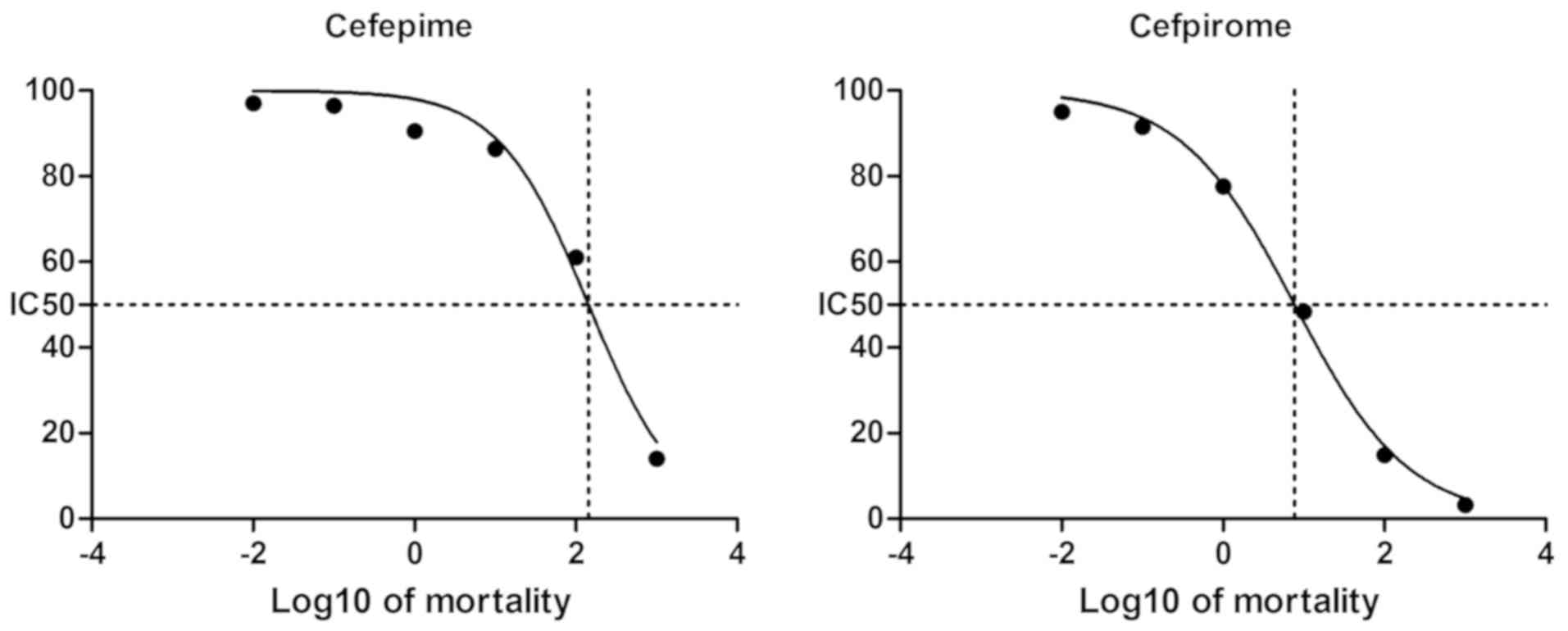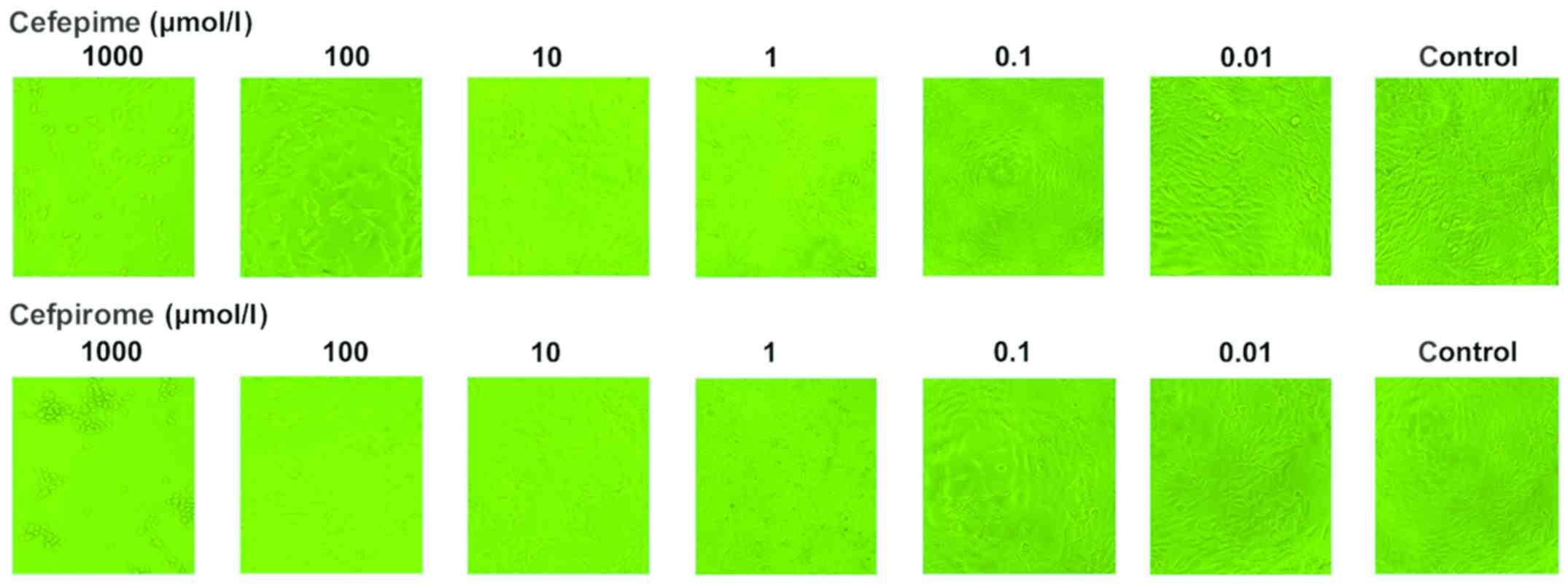Comparison of the influence on renal function between cefepime and cefpirome
- Authors:
- Published online on: October 6, 2015 https://doi.org/10.3892/br.2015.528
- Pages: 40-44
Abstract
Introduction
The cephalosporin nucleus has proved to be significantly amenable to modification, allowing more derivatives with different properties. The fourth-generation cephalosporins have been noted for their stability to β-lactamase enzymes, with a markedly reduced affinity for β-lactamase and increased outer membrane permeability compared to third-generation cephalosporins, thus making them widely used in clinical infectious diseases. A review of clinical studies indicates that fourth-generation cephalosporins are potentially useful as a first-line empiric therapy for serious infections, including severe community-acquired and nosocomial pneumonia, bacteremia, febrile episodes in neutropenic patients and meningitis (1). Among them, cefepime and cefpirome were most available due to their well-balanced antibacterial spectrum (2).
Previous studies mostly focused on the efficacy of fourth-generation cephalosporins; however, few clinical studies reported their associated renal function adverse effects (3–5). Cefpirome caused nephrotoxic symptoms in a rabbit model and the results suggested that cefpirome is potentially nephrotoxic compared to cefazolin, particularly in a single administration (6,7). Additionally, for the clinical patients at the top three hospitals in Nanjing, the serum creatinine (SCr) level was observed to augment during treatment of cefepime and cefpirome, which indicated the influence associated with fourth-generation cephalosporins on renal function. Therefore, the present study carried out an investigation on the nephrotoxic potential of cefepime and cefpirome in vitro and in a clinical cohort study.
Materials and methods
In vitro cytotoxicity assay
Renal mesangial cells were used in the cell viability assay. Cells were seeded 12–16 h before drug treatment at densities of 10,000 cells per well. Six drug dilutions were prepared as follows: 1,000, 100, 10, 1, 0.1 and 0.01 µmol/l. The growth medium without drugs was set as the control group. Each dilution group was tested in five duplicates. The drug solution was added into the wells and cells were cultured at 37°C in 5% CO2. A total of 24 h later, the drug solution was removed and each well was fed with fresh medium containing 3-(4,5-dimethylthiazol-2-yl)-2,5-diphenyltetrazolium bromide (MTT) and incubated for another 4 h. The medium and MTT were removed and the MTT-formazan crystals were dissolved by dimethyl sulfoxide. The optical values were tested at 570 nm. Data were analyzed by SPSS version 18.0 (SPSS, Inc., Chicago, IL, USA) and Graphpad prism 5.0 software (GraphPad Software, Inc., La Jolla, CA, USA).
Clinical cohort study
A total of 944 hospitalized patients who were randomly selected from a third-grade class-A teaching hospital (the Second Affiliated Hospital of Nanjing Medical University, of Nanjing Medical University, Nanjing, China) between January 2009 and December 2012 were included in the cohort study. The inclusion criteria were patients who needed to receive conventional treatment (2.0 g every 12 h) of fourth-generation cephalosporin (cefepime or cefpirome) according to clinical diagnosis, additionally with an originally normal renal function and creatinine clearance rate. Excluded criteria included chronic renal insufficiency, nephrotic syndrome, renal transplantation, previous use of aminoglycoside antibiotic drugs, combined-use of antimicrobial agents and previous treatment of nephrotoxic drugs. Patients were divided by drug treatment and among each drug group, patients were divided into two age groups: <65 and ≥65 years. The clinical characteristics of patients included are described in Table I.
The renal function of patients was tested by examining the SCr level before, and on days 3 and 7 during the therapy. Following this, the average levels of SCr in each group were calculated; the incidence of SCr >445 µmol/l, as an indicator for potential renal failure, was recorded.
Statistical analysis
P<0.05 was considered to indicate a statistically significant difference.
Results
Comparison of the effects on cell viability of cefepime and cefpirome on renal mesangial cells
As depicted in Table II and Fig. 1, cefepime and cefpirome showed significant inhibition on cell activity compared to the control group and the inhibition rate was dependent on the drug concentration. In each dilution group, cefpirome exhibited a higher inhibition on cell viability than cefepime, as shown in Table II and Fig. 2. Additionally, the half maximal inhibitory concentration (IC50) of the drugs on renal mesangial cells for 24 h was 143.5 and 7.702 µmol/l for cefepime and cefpirome, respectively.
Table II.Optical value (OD) at 570 nm and inhibition rate of drugs on renal mesangial cells treated with cephalosporins. |
Changes of serum creatine level following treatment with cefepime or cefpirome
As shown in Table III, treatment of cefepime resulted in a greater increase of SCr in the two age groups compared to cefpirome. In patients aged <65 years, cefepime rose from an average SCr level of 67±7.4 to 83±11.1 µmol/l on day 3 and 87±10.3 µmol/l on day 7, while cefpirome augmented an average SCr level from 65±8.7 to 95±10.9 µmol/l on day 3 and 98±14.2 µmol/l on day 7. On day 3, none of the patients suffered from SCr >445 µmol/l in the cefepime group, but one patient suffered in the cefpirome group (incidence, 0.6%). On day 7, one case in the cefepime group (incidence, 0.6%) and two additional cases in the cefpirome group (incidence, 1.9%) exhibited SCr >445 µmol/l, as shown in Table IV.
Table III.Comparison of the changes of serum creatinine levels during treatment of fourth-generation cephalosporins. |
Table IV.Comparison of the serum creatinine (SCr) >445 µmol/l incidences in the two fourth-generation cephalosporins groups. |
In patients aged ≥65 years, a higher increase of SCr was observed for the two drugs. In the cefepime group, the average SCr level was 91±11.7 µmol/l on day 3 and 102±11.8 µmol/l on day 7, while for the cefepime group the level was 130±12.4 and 155±13.1 µmol/l on days 3 and 7, respectively. Among the ≥65 age group, the incidence of SCr >445 µmol/l increased, which was 0.3% (one case) on day 3 and 0.7% (two cases) on day 7 for the cefepime group, and 1.3% (four cases) on day 3 and 3.2% (10 cases) on day 7 for the cefpirome group, as depicted in Tables III and IV.
Discussion
As a large group of associated β-lactam antimicrobial agents, the cephalosporins possess various advantages, including low rates of toxicity, relatively broad activity spectrum and ease of administration on clinical treatment against infectious diseases. Currently, the fourth-generation cephalosporins are used more widely as the drug-resistant condition grows more severe, among which cefpirome and cefepime are the most available and used. Cephalosporins cause renal toxicity and cephaloridine was noted as the most nephrotoxic (8). Corresponding mechanisms include lipid peroxidation, competitive inhibition of mitochondrial carnitine transport, fatty acid oxidation and acylation, and inactivation of tubular cell proteins. The fourth-generation cephalosporins were revealed to cause renal damage in animal models (9–11). Therefore, the potential influence on renal function of fourth-generation cephalosporins should be considered as a matter of concern.
In the present study, cefepime and cefpirome caused significant cytotoxicity on renal mesangial cells and cefpirome with a higher IC50 on cell viability may be more renal cytotoxic than cefepime. Consistent results were observed in the clinical cohort study. Cefpirome was observed to cause a greater elevation of the average SCr level, as well as the incidence of SCr >445 µmol/l compared to the cefepime group. Within each drug group, the ≥65 years subgroup was more susceptive to nephrotoxicity caused by drugs, with a larger increase of the average SCr levels and higher incidence of SCr >445 µmol/l. Cefpirome had more potential to induce renal damage compared to cefepime. Future studies should focus on renal interstitial cells, as the majority of observed renal damage caused by cephalosporins are interstitial nephritis. In addition, further clinical indicators associated with renal function are required for a deeper insight of the adverse effects of fourth-generation cephalosporins. Animal models should be designed to well expound the mechanisms of potential nephrotoxicity of fourth-generation cephalosporins.
In conclusion, the two fourth-generation cephalosporins have nephrotoxic potential and cefpirome has a greater tendency to cause renal damage. Additional attention should be paid to elder patients. Cefpirome should be a more cautious choice in clinical treatment.
Acknowledgements
The present study was sponsored by the Health Department of Jiangsu province (grant no. H200911).
References
|
Garau J, Wilson W, Wood M and Carlet J: Fourth-generation cephalosporins: A review of in vitro activity, pharmacokinetics, pharmacodynamics and clinical utility. Clin Microbiol Infect. 3(Suppl 1): s87–s101. 1997. View Article : Google Scholar | |
|
Gould IM: Do we need fourth-generation cephalosporins? Clin Microbiol Infect. 5:S1–S5. 1999. View Article : Google Scholar : PubMed/NCBI | |
|
Saito T, Ichinohe T, Kanda J, et al: Historical cohort study of the efficacy and safety of piperacillin/tazobactam versus fourth-generation cephalosporins for empirical treatment of febrile neutropenia in patients with hematological malignancies. Int J Clin Med. 2:18–22. 2011. View Article : Google Scholar | |
|
Hoffman JM, Frediani J, Herr M, Flynn PM and Adderson EE: The safety of cefepime and ceftazidime in pediatric oncology patients. Pediatr Blood Cancer. 60:806–809. 2013. View Article : Google Scholar : PubMed/NCBI | |
|
Gonçalves-Pereira J and Póvoa P: Antibiotics in critically ill patients: A systematic review of the pharmacokinetics of β-lactams. Crit Care. 15:R2062011. View Article : Google Scholar : PubMed/NCBI | |
|
Deki T, Matsuoka A, Marutani K, et al: Nephrotoxicity of cefpirome sulfate in rabbits - single and multiple intravenous administration. J Toxicol Sci. 15(Suppl 3): 173–200. 1990.(In Japanese). View Article : Google Scholar : PubMed/NCBI | |
|
Cojocel C: Biochemical aspects of the renal tolerance for cefpirome and other cephalosporins. Arzneimittelforschung. 40:1140–1144. 1990.PubMed/NCBI | |
|
Tune BM: Nephrotoxicity of β-lactam antibiotics: Mechanisms and strategies for prevention. Pediatr Nephrol. 11:768–772. 1997. View Article : Google Scholar : PubMed/NCBI | |
|
Rokushima M, Fujisawa K, Furukawa N, et al: Transcriptomic analysis of nephrotoxicity induced by cephaloridine, a representative cephalosporin antibiotic. Chem Res Toxicol. 21:1186–1196. 2008. View Article : Google Scholar : PubMed/NCBI | |
|
Soni A, Chaudhary M and Dwivedi VK: Ceftriaxone-vancomycin drug toxicity reduction by VRP 1020 in Mus musculus mice. Curr Clin Pharmacol. 4:95–101. 2009. View Article : Google Scholar : PubMed/NCBI | |
|
Yılmaz N, Ilhan S, Nazıroğlu M, Oktar S, Nacar A, Arıca V and Tutanç M: Ceftriaxone ameliorates cyclosporine A-induced oxidative nephrotoxicity in rat. Cell Biochem Funct. 29:102–107. 2011. View Article : Google Scholar : PubMed/NCBI |











